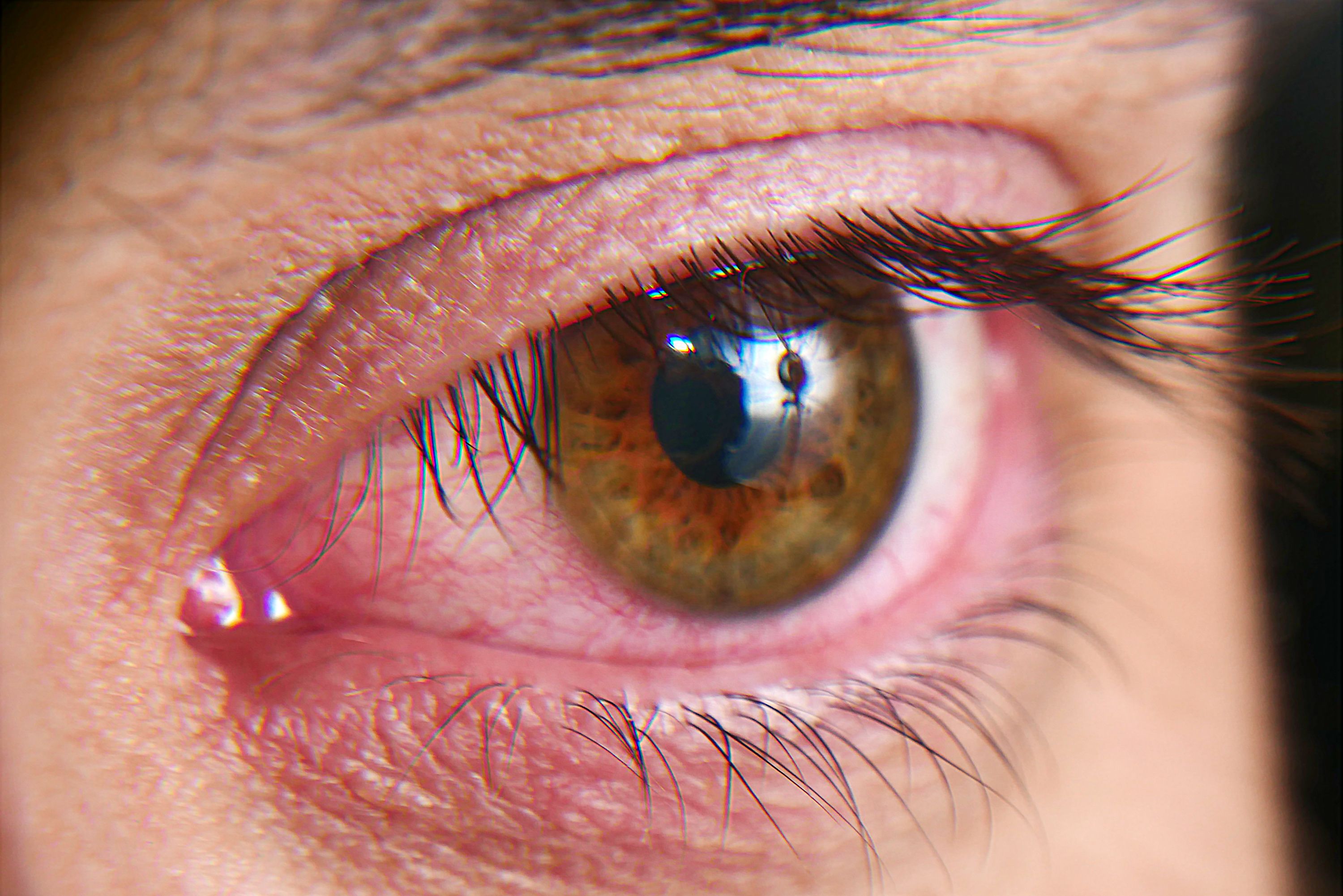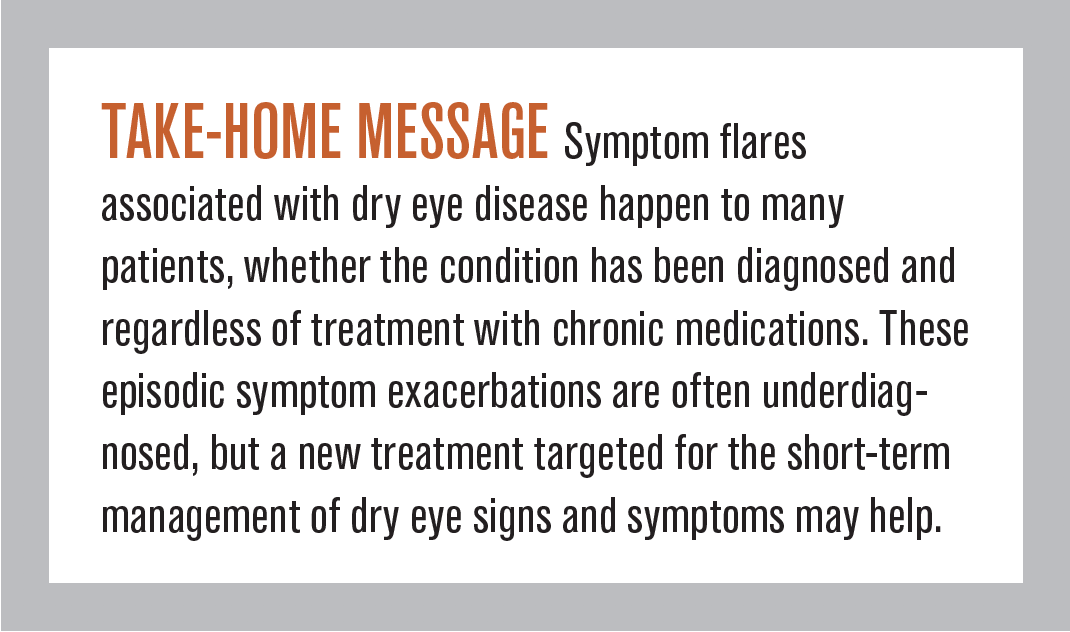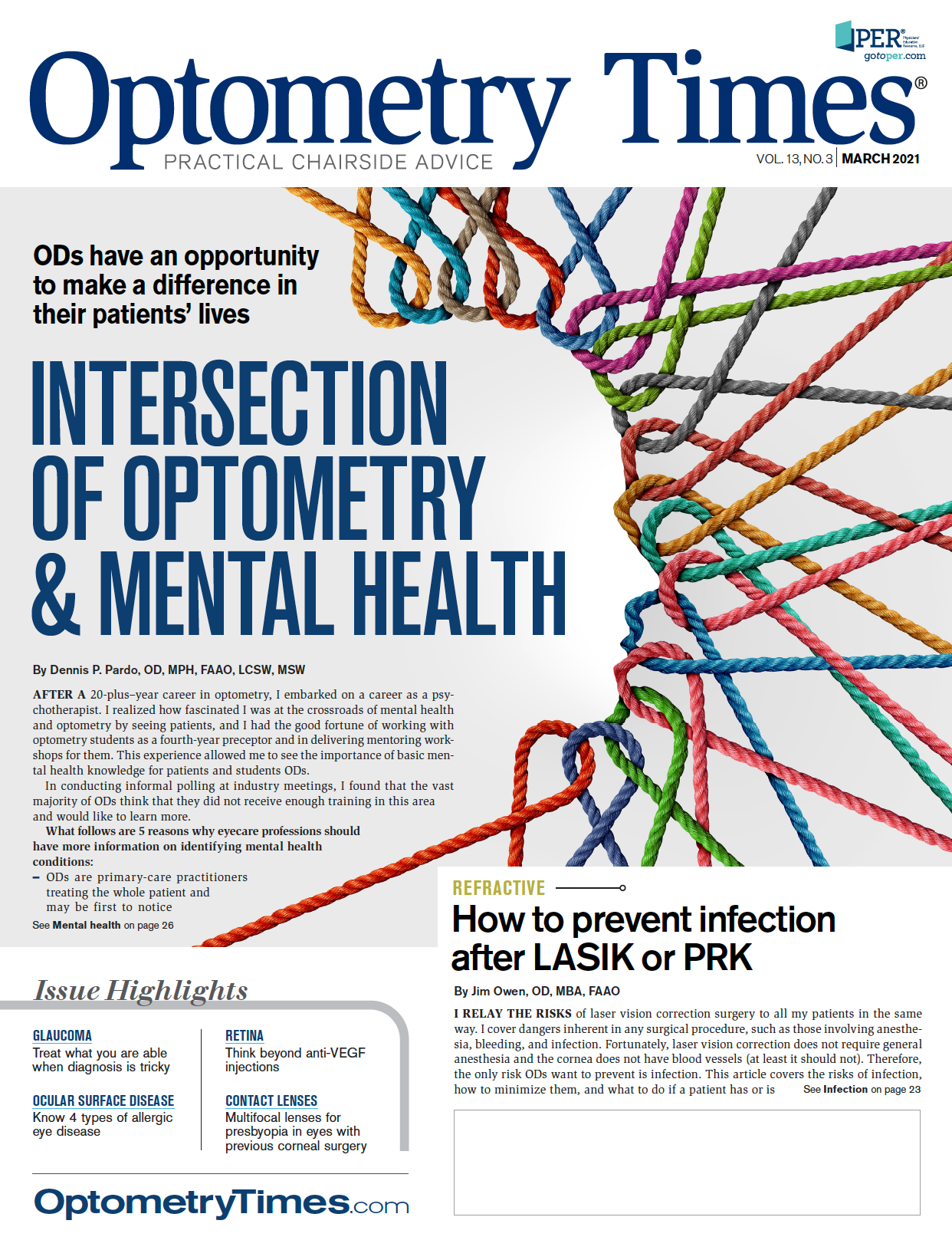New therapy addresses dry eye flares
When patients experience symptomatic flares, go into overdrive and fight back fast


Although dry eye disease (DED) is widely known to be a chronic and symptomatic condition, it can also be episodic. This means that patients commonly have periods of time when their symptoms are exacerbated when inflammation is the underlying cause.1-4
During symptomatic flares, many patients do not seek care or reach more often for artificial tears. With the recent FDA approval of loteprednol etabonate ophthalmic suspension 0.25% (Eysuvis; Kala Pharmaceuticals), ODs now have a prescription agent specifically designed to treat signs and symptoms of DED associated with short-term flares.
Symptomatic flares
These periods of symptom flares can be triggered by environmental changes, such as heat and air conditioning, airplane travel, or seasonal allergies. Contact lens wear and cataract and refractive surgery can also cause flares, as well as excessive digital device use which has increased dramatically during the pandemic.5
In order to identify and appropriately treat these flares, it is important that ODs ask all patients the right questions during visits. Prompting patients to think about and describe their symptoms over time, not just how their eyes feel on the day of the visit, can provide a complete picture of their condition.
About 80% to 90% of patients who receive a diagnosis of DED can have periods of exacerbations or flares.6,7 Even though some patients with severe DED may do well on their maintenance medication like lifitegrast (Xiidra, Novartis) or cyclosporine (Restasis, Allergan; Cequa, Sun Ophthalmics), the majority experience flares with or without chronic treatment. In clinic, ODs may see patients who, despite whatever strategies they are employing, still have flares.
Nearly half of patients identified as having dry eye flares experience flares alone rather than continuous symptoms, which suggests that these discussions are needed with patients.6,7 When patients experience flares, they typically self-treat through episodes with artificial tears and lubricating drops with limited and transient success because these OTC products do not address the underlying inflammation driving the flare.8,9 This is where Eysuvis might serve as a potential first-line approach.
Data details
Investigators studied Eysuvis for the short-term treatment of the signs and symptoms of DED in a phase 2 and 3 phase 3 trials, representing the largest dry eye clinical development program conducted for DED with data on more than 2800 patients.10 In the STRIDE clinical trials, researchers observed improvement in the measures of conjunctival hyperemia, corneal fluorescein staining, and patient-reported ocular discomfort severity score. Patients assigned to treatment with Eysuvis experienced symptom improvement as early as day 2.
Eysuvis demonstrated a beneficial safety profile: intraocular pressure (IOP) was similar among the vehicle and Eyesuvis arms. In treatment and vehicle groups, respectively, 0.6% and 0.2% of patients experienced an over 5 mm Hg increase from baseline resulting in an IOP measurement of 21 or more mm Hg in one or both eyes at any post-baseline visit.10
Eysuvis is formulated with Ampplify, Kala Pharmaceuticals’ proprietary mucus-penetrating particle technology. These nanoparticles, which are less than 500 nm in size, are coated to facilitate their mucus barrier penetration. This allows the drug to spread more uniformly on the ocular surface to achieve longer retention.
Ask the right questions
Patients who have dry eye flares may not discuss their episodic symptom patterns during their routine office visits because they are not necessarily thinking about how their eyes feel over time. Therefore, it is important that eye care providers specifically ask about symptom fluctuation throughout the year and exacerbations in certain environments or situations. It is easy to miss flares unless patients are asked the right questions: are there any times that your eyes feel worse? Have you noticed any patterns? Are there times when your maintenance therapy is not enough? A simple questionnaire could easily facilitate this conversation with patients.
Data show that patients with DED have an average of about 4 to 6 dry eye flares per year, lasting between 7 and 14 days.6 When flares happen, patients struggle through the episode, typically self-treating with OTC therapies that fall short because they do not address the underlying inflammatory cycle. A physician-led strategy is needed to manage flares that could potentially quiet the whole inflammatory cycle and help stop the disease from progressing. With Eyesuvis now available to treat these flares, practitioners can be cognizant ask patients what happens with their symptoms throughout the year and treat accordingly.
Conclusion
Eye care providers are beginning to recognize that patients experience dry eye flares. Asking targeted questions about symptoms over time can help direct more comprehensive treatment strategies. Eysuvis, a short-term, fast-acting corticosteroid therapy that addresses both signs and symptoms of flares can help manage exacerbations. This new tool should encourage eye care providers to dig deeper into patients’ symptoms over time so they can confidently provide an effective solution.

References
1. Bron AJ, de Paiva CS, Chauhan SK, et al. TFOS DEWS II pathophysiology report. Ocul Surf. 2017;15(3):438-510. doi:10.1016/j/ jtos.2017.05.011
2. Amparo F, Dana R. Web-based longitudinal remote assessment of dry eye symptoms. Ocul Surf. 2018;16(2):249-253. doi:10.1016/j. jtos.2018.01.002
3. Iyer JV, Lee SY, Tong L. The dry eye disease activity log study The dry eye disease activity log study. ScientificWorldJournal. 2012;2012:589875. doi:10.1100/2012/589875
4. Kim Y, Paik HJ, Kim MK, Choi YH, Kim DH. Short-term effects of ground-level ozone in patients with dry eye disease: a prospective clinical study. Cornea. 2019;38(12):1483-1488. doi:10.1097/ ICO.0000000000002045
5. Akpek EK, Amescua G, Farid M, et al; American Academy of Ophthalmology Preferred Practice Pattern Cornea/External Disease Committee. Dry Eye Syndrome PPP - 2018. American Academy of Ophthalmology. November 2018. Accessed February 17, 2021. https:// www.aao.org/preferred-practice-pattern/dry-eye-syndrome-ppp-2018
6. 2020 Study of Dry Eye Sufferers. Multi-sponsor Surveys, Inc. July 2020. Accessed February 19, 2021. https://www.multisponsor.com/wp-content/uploads/2020/11/2020-Dry-Eye-Sufferers-MS2004.pdf
7. Brazzell RK, Zickl L, Farrelly J, Holland E, et al. Prevalence and characteristics of dry eye flares: a patient questionnaire survey. Poster presented at: American Academy of Ophthalmology Annual Meeting: October12-15, 2019; San Francisco, CA.
8. Jones L, Downie LE, Korb D, et al. TFOS DEWS II management and therapy report. Ocul Surf. 2017;15(3):575-628. doi:10.1016/j. jtos.2017.05.006
9. Sheppard JD, Comstock TL, Cavet ME. Impact of the topical ophthalmic corticosteroid loteprednol etabonate on intraocular pressure. Adv Ther. 2016;33(4):532-552. doi:10.007/s12325-016-0315-8
10. Holland E, Nichols K, Foulks G, Gupta PK. Efficacy and Safety of KPI- 121 0.25% for Short Term Relief in Dry Eye (STRIDE). Poster presented at: American Society of Cataract and Refractive Surgery annual meeting; May 16-17, 2020; Virtual.
11. Korenfeld M, Nichols KK, Goldberg D, E, et al. Safety of KPI-121 ophthalmic suspension 0.25% in patients with dry eye disease: a pooled analysis of 4 multicenter, randomized, vehicle-controlled studies. Cornea. Published online August 19, 2020. doi: 10.1097/ ICO.0000000000002452

Newsletter
Want more insights like this? Subscribe to Optometry Times and get clinical pearls and practice tips delivered straight to your inbox.